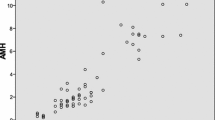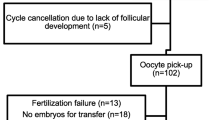Abstract
Purpose
To evaluate the clinical value of day 3 serum anti-Müllerian hormone (AMH) compared with day 3 serum follicle-stimulating hormone (FSH) and human chorionic gonadotropin (hCG) day estradiol (E2) levels and antral follicle count (AFC) in the prediction of poor ovarian response in controlled ovarian hyperstimulation (COH).
Methods
AMH, FSH and AFC on day 3 as well as hCG day E2 levels were determined in 164 subjects. Receiver operating curve analyses and area under curves (AUC) of the study parameters were performed. Predictive values of the levels of day 3 AMH, FSH, AFC, and hCG day E2 as clinical parameters of ovarian response to COH were studied.
Results
Thirty-eight women were defined as poor responders. The day 3 AMH and hCG day E2 levels and AFC of normal responders were significantly higher than those of the poor responders. In predicting poor response, the AUC of day 3 AMH level was significantly higher than that of day 3 FSH level but was similar to the hCG day E2 level. Day 3 AMH, FSH and hCG day E2 levels and AFC were found to predict a poor response. Day 3 AMH and hCG day E2 levels were more predictive compared with day 3 FSH level and AFC. The cut-off level of AMH was ≤2 with a sensitivity of 78.9% and a specificity of 73.8%.
Conclusion
Day 3 AMH has the ability to predict a poor response to COH and it is more predictive than day 3 FSH and AFC.

Similar content being viewed by others
References
Broer SL, Mol B, Dólleman M, Fauser BC, Broekmans FJ. The role of anti-Müllerian hormone assessment in assisted reproductive technology outcome. Curr Opin Obstet Gynecol. 2010;22:193–201.
Navot D, Rosenwaks Z, Margalioth EJ. Prognostic assessment of female fecundity. Lancet. 1987;19:645–7.
Fanchin R, de Ziegler D, Olivennes F, Taieb J, Dzik A, Frydman R. Exogenous follicle stimulating hormone ovarian reserve test (EFORT): a simple and reliable screening test for detecting ‘poor responders’ in in vitro fertilization. Hum Reprod. 1994;9:1607–11.
Faddy MJ, Gosden RG. A model conforming the decline in follicle numbers to the age of menopause in women. Hum Reprod. 1996;11:1484–6.
Lass A, Skull J, McVeigh E, Margara R, Winston RM. Measurement of ovarian volume by transvaginal sonography before ovulation induction with human menopausal gonadotrophin for in vitro fertilization can predict poor response. Hum Reprod. 1997;12:294–7.
Tomas C, Nuojua-Huttunen S, Martikainen H. Pretreatment transvaginal ultrasound examination predicts ovarian responsiveness to gonadotrophins in in vitro fertilization. Hum Reprod. 1997;12:220–3.
Hall JE, Welt CK, Cramer DW. Inhibin A and inhibin B reflect ovarian function in assisted reproduction but are less useful at predicting outcome. Hum Reprod. 1999;14:409–15.
Bancsi LF, Broekmans FJ, Eijkemans MJ, de Jong FH, Habbema JD, te Velde ER. Predictors of poor ovarian response in in vitro fertilization: a prospective study comparing basal markers of ovarian reserve. Fertil Steril. 2002;77:328–36.
Broekmans FJ, Kwee J, Hendriks DJ, Mol BW, Lambalk CB. A systematic review of tests predicting ovarian reserve and IVF outcome. Hum Reprod Update. 2006;12:685–718.
Fiçicioglu C, Kutlu T, Baglam E, Bakacak Z. Early follicular antimüllerian hormone as an indicator of ovarian reserve. Fertil Steril. 2006;85:592–6.
Durlinger AL, Visser JA, Themmen AP. Regulation of ovarian function: the role of anti Mullerian hormone. Reproduction. 2002;124:601–9.
Visser JA, de Jong FH, Laven JS, Themmen AP. Anti-Müllerian hormone: a new marker for ovarian function. Reproduction. 2006;131:1–9.
Fréour T, Mirallié S, Colombel A, Bach-Ngohou K, Masson D, Barrière P. Anti-mullerian hormone: clinical relevance in assisted reproductive therapy. Ann Endocrinol. 2006;67:567–74.
Hendriks DJ, Mol BW, Bancsi LF, Te Velde ER, Broekmans FJ. Antral follicle count in the prediction of poor ovarian response and pregnancy after in vitro fertilization: a meta-analysis and comparison with basal follicle-stimulating hormone level. Fertil Steril. 2005;83:291–301.
Tarlatzis BC, Zepiridis L, Grimbizis G, Bontis J. Clinical management of low ovarian response to stimulation for IVF: a systematic review. Hum Reprod Update. 2003;9:61–76.
Ulug U, Ben-Shlomo I, Turan E, Erden HF, Akman MA, Bahceci M. Conception rates following assisted reproduction in poor responder patients: a retrospective study in 300 consecutive cycles. Reprod Biomed Online. 2003;6:439–43.
Saldeen P, Källen K, Sundström P. The probability of successful IVF outcome after poor ovarian response. Acta Obstet Gynecol Scand. 2007;86:457–61.
Galey-Fontaine J, Cédrin-Durnerin I, Chaïbi R, Massin N, Hugues JN. Age and ovarian reserve are distinct predictive factors of cycle outcome in low responders. Reprod Biomed Online. 2005;10:94–9.
van Disseldorp J, Lambalk CB, Kwee J, Looman CW, Eijkemans MJ, Fauser BC, Broekmans FJ. Comparison of inter- and intra-cycle variability of anti-Mullerian hormone and antral follicle counts. Hum Reprod. 2010;25:221–7.
Jayaprakasan K, Campbell B, Hopkisson J, Johnson I, Raine-Fenning N. A prospective, comparative analysis of anti-Müllerian hormone, inhibin-B, and three-dimensional ultrasound determinants of ovarian reserve in the prediction of poor response to controlled ovarian stimulation. Fertil Steril. 2010;93:855–64.
Singer T, Barad DH, Weghofer A, Gleicher N. Correlation of antimüllerian hormone and baseline follicle-stimulating hormone levels. Fertil Steril. 2009;91:2616–9.
Gnoth C, Schuring AN, Friol K, Tigges J, Mallmann P, Godehardt E. Relevance of anti-Mullerian hormone measurement in a routine IVF program. Hum Reprod. 2008;23:1359–65.
Nardo LG, Christodoulou D, Gould D, Roberts SA, Fitzgerald CT, Laing I. Anti-müllerian hormone levels and antral follicle count in women enrolled in in vitro fertilization cycles: relationship to lifestyle factors, chronological age and reproductive history. Gynecol Endocrinol. 2007;23:486–93.
La Marca A, Giulini S, Tirelli A, Bertucci E, Marsella T, Xella S, Volpe A. Anti-Müllerian hormone measurement on any day of the menstrual cycle strongly predicts ovarian response in assisted reproductive technology. Hum Reprod. 2007;22:766–71.
Seifer DB, Maclaughlin DT. Mullerian inhibiting substance is an ovarian growth factor of emerging clinical significance. Fertil Steril. 2007;88:539–46.
Nakhuda GS. The role of mullerian inhibiting substance in female reproduction. Curr Opin Obstet Gynecol. 2008;20:257–64.
Bersinger NA, Wunder D, Birkhäuser MH, Guibourdenche J. Measurement of anti-mullerian hormone by Beckman Coulter ELISA and DSL ELISA in assisted reproduction: differences between serum and follicular fluid. Clin Chim Acta. 2007;384:174–5.
Author information
Authors and Affiliations
Corresponding author
About this article
Cite this article
Sahmay, S., Cetin, M., Ocal, P. et al. Serum anti-Müllerian hormone level as a predictor of poor ovarian response in in vitro fertilization patients. Reprod Med Biol 10, 9–14 (2011). https://doi.org/10.1007/s12522-010-0066-1
Received:
Accepted:
Published:
Issue Date:
DOI: https://doi.org/10.1007/s12522-010-0066-1




